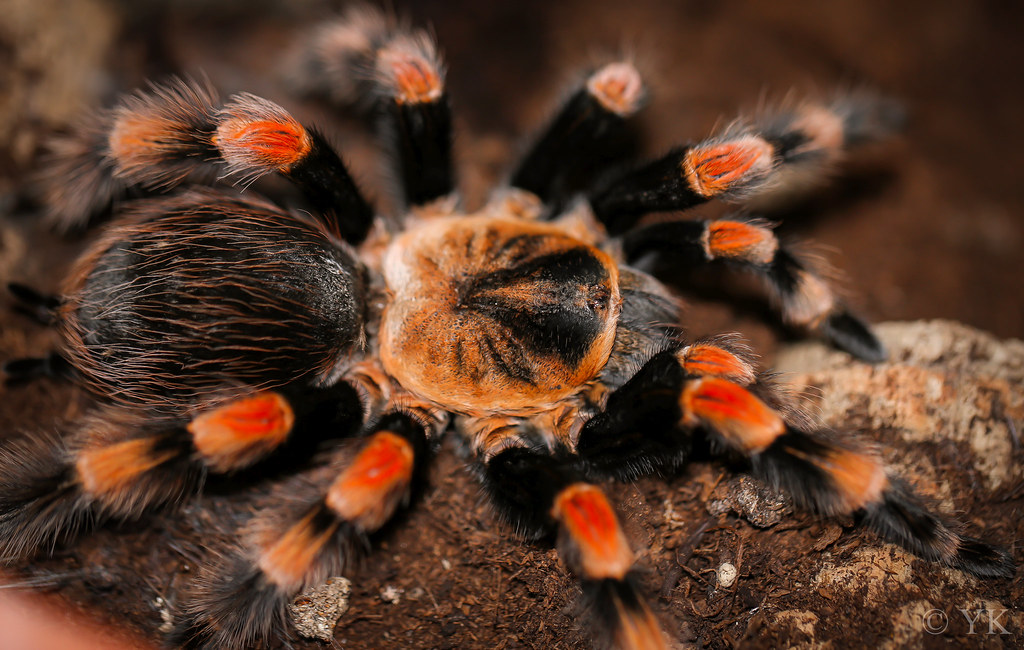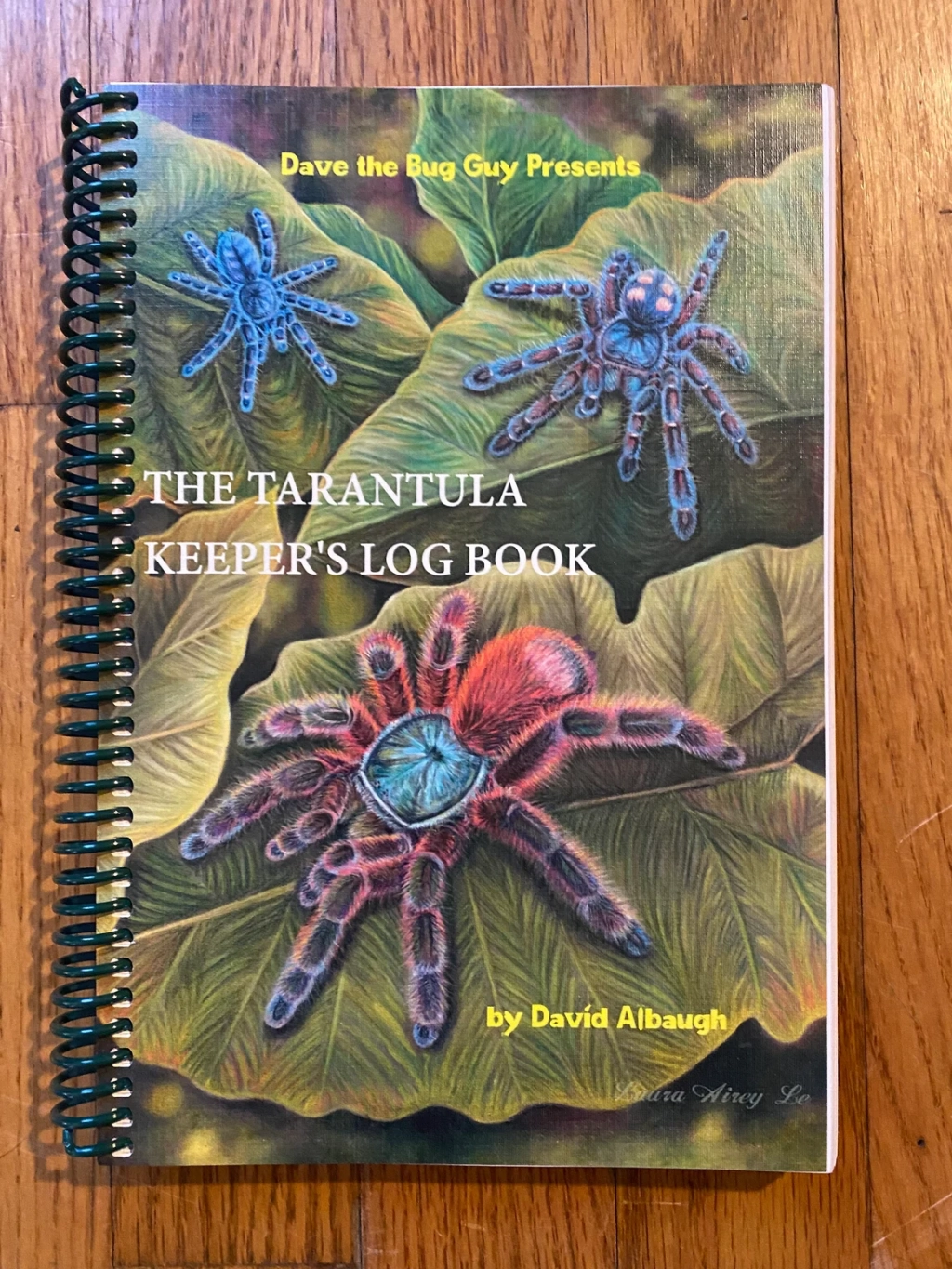The first tarantula I ever had was Brachypelma hamorii, then known as smithi. I had her for fifteen years, after my parents bought her for me in 1979 from a local pet shop. Since then, though I now keep many genuses of tarantulas, Brachypelma will always hold a special place in my heart. They are easy to keep, are very long lived, and all are absolutely beautiful. In 2019, many Brachypelma species were re-designated under the new genus Tliltocatl. According to the World Spider Catalog, there are currently eight species of Brachypelma, all originating from Mexico. Thanks to captive-breeding efforts within the United States, most of these are readily available as spiderlings. All species are protected, and trade is regulated under CITES.

Members of the family Theraphosidae, the tarantulas, to which Brachypelma belongs, are generally large compared to other spiders, and are commonly seen as “objects of dread”. Tarantulas do not use webs for capturing their prey, relying on their venom and their size and strength. Brachypelma species are noted for their large size, colorfulness and docility in captivity. Larger species of Brachypelma, such as B. smithi, have body lengths in the approximate range 45–60 mm (1¾ – 2⅟4) with legs up to 70 mm (2¾ in) long. Females on average have longer bodies than males but shorter legs.
Species have bright red markings on their legs. B. boehmei has been described as the “most gorgeous” species of the genus. The parts of the legs closest to the body are black, then three segments (the patellae, tibiae and metatarsi) are bright orange yellow, followed by black tarsi. Although brightly colored, Brachypelma species are cryptic when in their native habitat.

The distribution of hairs on the legs and palp and the shape of the male and female genitalia are the diagnostic features of the genus. In common with species of Tliltocatl, the prolateral (forward facing) surface of the trochanter and femur of the first leg and the retro lateral surface of the pedipalp have plumose hairs, and there is no pad of plumose hairs on the femur of the fourth leg. The male palpal bulb has a flattened, spoon-shaped embolus; females have fused spermathecae, with a flat cross-section. Brachypelma can be distinguished from Tliltocatl by presence of the red or orange patterns on the legs of all species except B. albiceps, which can be recognized by the golden yellow carapace. Brachypelma species lack spines on the patellae of the pedipalps and legs, unlike Tliltocatl species. The shape of the genitalia differs between the genera; the apex of the male palpal bulb is shorter in Brachypelma and the female spermatheca baseplate is more strongly developed and hardened.
All the species of Brachypelma that have been studied in detail live in burrows. These have a single entrance, a little larger than the spider, opening into a horizontal tunnel that usually leads to two chambers: one where it molts and one where it rests and consumes its prey. The entrance is blocked with material, such as soil and leaves, bound together by silk when the spider is inactive for significant length of time; otherwise, the entrance is open with some silk visible. North American tarantulas like Brachypelma are “sit and wait” predators, seizing prey passing by the burrow entrance.

Compared to related genera, Brachypelma species are long-lived. The maximum lifespan recorded in two Berlin zoos was 12 years for Brachypelma annitha (now a synonym of B. smithi). In the wild, females take around 9–10 years to reach maturity but can then live for another 10 years. Males can take 7–8 years to reach maturity, afterwards usually dying within a year, probably because when mature they actively seek mates and rarely feed while doing so, whereas females remain around their burrows.
Studies on species in the wild showed that pre-adult and adult spiders molt towards the end of the dry season, which lasts from June to November. After their last molt, adult males search for females, travelling in the daytime, particularly in the morning and evening. Females produce an egg sac before they molt. The eggs hatch a few weeks before the rainy season begins. The spiderlings molt every two weeks for the first few months, then less frequently as they mature. A full-grown Brachypelma may molt as infrequently as once a year.

Habitat destruction and collection for the pet trade have led to these spiders being among the few arthropods protected under international Convention on International Trade of Endangered Species rules. In 1985, B. smithi (then not distinguished from B. hamorii) was placed on CITES Appendix II, and in 1994, all remaining Brachypelma species were added. Large numbers of Mexican tarantulas caught in the wild continue to be smuggled out of Mexico. It is reported that at least 3,000 specimens of Mexican tarantulas were sent to the United States or Europe a few years prior to 2017, most of which were Mexican red knee tarantulas (B. hamorii and B. smithi). Turner and colleagues suggest that members of Brachypelma (their “red leg” group), which have small ranges and are slow to mature and reproduce, should be the focus of urgent conservation measures, with threats to species in the genus Tliltocatl (their “red rump” group) possibly being downgraded.
Brachypelma albiceps (Pocock, 1903)

Brachypelma albiceps, the Mexican Gold Red Rump Tarantula, is a stunning tarantula and generally very docile. The carapace is a light golden color and the abdomen dark, covered with long red hairs. Females typically live for about 15 years (up to 20). Males usually live about 5 years or up to 12 months after the last molt. Brachypelma albiceps is endemic to the central highlands of Mexico, especially in Guerrero and south of Morelos. In the wild, they build long burrows, typically under large rocks, but may inhabit nests abandoned by rodents or other animals. They are most active at night and dusk.
They tend to grow faster than others in the Genus. They tend to be calm and move very little, unless catching prey items. They are very hardy and one of the easiest New World species to keep. Though they don’t seem to appear often in pet stores, most online dealers have them available for sale as babies.
Brachypelma auratum (Schmidt, 1992)

Brachypelma auratum, the Mexican Flame Knee Tarantula, looks similar to Brachypelma hamorii except for the bright orange markings on the patella. It is endemic to the regions of Guerrero and Michoacán in Mexico. Due to the species’ similarities to B. smithi, it was not considered a distinct species until 1992. It has been found living communally with a small frog known as Eleutherodactylus occidentalis. Though more research is still to be done on the exact nature of their relationship, it seems the frog benefits from some protection from predators and the tarantula benefits from the frog eating any small insects or parasites which may attack the tarantula or its egg sac. This species is a slow grower and tends to be more nervous than others of the genus, often flicking urticating hairs. This species is readily available from online dealers as spiderlings.
Brachypelma baumgarteni (Smith, 1993)

Brachypelma baumgarteni, also called Mexican Orange Beauty, is a tarantula endemic to Pacific coast of Michoacan, Mexico. B. baumgarteni was thought to be a captive hybrid of B. smithi crossed with B. boehmei, because for a long time no specimen had been reported successfully bred in captivity. Their growth rate is slightly faster than most Brachypelmas and it is very docile. This is one of the rarest of Brachypelmas, not often available in the hobby.
Brachypelma boehmei (Schmidt & Klaas, 1993)

Brachypelma boehmei, also known as the Mexican Fire Leg Tarantula, is a native to Mexico in Guerrero state. These long-lived tarantulas prefer burrowing and hiding in dry scrubland. As with all closely related tarantula species, they defend themselves with urticating hair when provoked. The Mexican Fire Leg resembles its better-known relative, the Mexican red knee tarantula Brachypelma hamorii, formerly confused with Brachypelma smithi, in its dramatic orange and black coloration, though the adults of the species range from 5 to 6 inches in size. This species of tarantula has a slower growth rate than many of the larger South American tarantula species. The black femora (upper legs) provide a dark dividing band between the rich orange color of the carapace and lower legs. Unlike the orange joints of Brachypelma hamorii, the legs of this species are a bright, fiery red on the patella (or knees), fading gradually to a paler orange further down and tipped by black tarsi (or feet).
This species was described by Schmidt & Klass in 1993 and females can grow to a little over 6.5 inches (17cm) and live as long as 25 years in captivity while the males tend to live only 7 or 8 years. The Mexican Fire Leg tends to be more defensive and skittish than other Brachypelma species, which are usually known for being docile. As juveniles and adults, boehmei are quick to kick hairs when annoyed, especially during rehousing, and have been known to quickly bolt a short distance to get away when they feel threatened. This species is readily available from online dealers and occasionally show up in pet stores.
Brachypelma emilia (White, 1856)

Brachypelma emilia, also known as the Mexican Red Leg Tarantula, is a species of terrestrial tarantula closely related to the famous Mexican Red Knee Tarantula. Like the Red Knee it is a docile tarantula and popular in the pet trade. It is slow growing and, like many tarantulas, females can live for decades.
Brachypelma emilia is one of the earliest described tarantulas. It is endemic to Mexico where it enjoys a large range across the Sierra Madres Occidental. Many specimens have a triangular marking on the carapace, but this can vary between individuals. This species comes from a dry climate and burrow temperatures can vary from 21-25 degrees but are notably cooler than the air temperature.
This tarantula has beautiful orange and black markings on the legs, with a darker colored carapace and abdomen, with the latter being clothed in red hairs. Like all Brachypelma, the spiderlings of B. emilia are not colorful and the adults are not sexually dimorphic in color. B. emilia is a slow growing species like most Brachypelma averaging 8-10 years to maturity and has a docile temperament. This species is readily available from online dealers.
Brachypelma hamorii (Cleton & Verdez, 1997)

The Brachypelma hamorii, formerly classified as the Brachypelma smithi, known commonly as the Mexican Red Knee Tarantula, is one of, if not the most, popular tarantula in the hobby. This species is endemic to Mexico found mainly along the western coast south of Guadalajara in the drier savannas and scrublands. This is a New World terrestrial, opportunistic burrower and was listed in CITES in 1985 due to dwindling numbers in the wild as a result of specimens being captured for the pet trade and other uses. These tarantulas were very popular in China at the time and the excessive importing had a huge effect on the number that could be found in the wild. This wasn’t the only issue facing this species as many of the local people where the Red Knee is found saw them as pests or even bad luck and would exterminate them on site, further leading to their dwindling numbers. Listing them on CITES protected the species from eradication and halted exportation without the proper documents permitting them to be removed and shipped out of the country.
Brachypelma hamorii was initially misidentified as the very similar B. smithi, a species originally described in 1897. In 1968, the holotype of B. smithi was found to be an immature male, and in 1994, A. M. Smith redescribed B. smithi using two adult specimens. The specimens cannot now be found, but his description makes it clear that they actually belonged to what is now B. hamorii, not B. smithi. B. hamorii was first described by Marc Tesmoingt, Frédéric Cleton and Jean Verdez in 1997. They stated that it was close to B. smithi, but could be distinguished by a number of characteristics, including the spermathecae of the females. However, following Smith’s description, B. hamorii continued to be misidentified as B. smithi until the situation was clarified by J. Mendoza and O. Francke in 2017.
The two species have very similar color patterns. When viewed from above, the chelicerae of B. hamorii have two brownish-pink bands on a greyish background, not visible on all individuals. B. smithi lacks these bands. Mature males of the two species can be distinguished by the shape of the palpal bulb. When viewed retro laterally, the palpal bulb of B. hamorii is narrower and less straight than the broad, spoon-shaped one of B. smithi. It also has a narrower keel at the apex. In mature females of B. hamorii, the baseplate of the spermatheca is elliptical, rather than divided and subtriangular as in B. smithi; also, the ventral face of the spermatheca is smooth rather than striated. This species is readily available from online dealers.
Brachypelma klaasi (Schmidt & Krause, 1994)

Brachypelma klaasi, also known as the Mexican Pink Tarantula, is endemic to Mexico and it is the rarest of the genus Brachypelma. The setae of this species have a uniformly rusty appearance. The coloration is very similar to that of the six species of Brachypelma that are endemic to the west coast. B. boehmei is similar, having black tarsi, orange-yellow metatarsi, tibias and patellas, black femora and coxae and orange-yellow hairs on the opisthosoma. It differs only in the carapace, which is yellow-orange in B. boehmei and black in B. klaasi. Another very similar species is B. baumgarteni. Adults of B. klaasi have a body length of about 6–7.5 cm with a 16 cm leg span.
B. klaasi is found at elevations of 300–1400 m above sea level on the western slopes of the Sierra Madre Occidental and some areas on the western limits of the Trans-Mexican Volcanic Belt in Jalisco and Nayarit states. Its known range extends from Tepic, Nayarit, in the north to Chamela, Jalisco, in the south, with the largest known population at the biological reserve at Chamela.
This species has a slow to medium growth and like others in the genus, are long-lived. They are calm though if scared, may flick urticating hairs. This species is also one of the rarest of the Brachypelmas, though have become more readily available from online dealers in recent years.
Brachypelma smithi (F.O. Pickard-Cambridge, 1897)

Brachypelma smithi, formerly known as Brachypelma annitha, is also known as the Mexican Giant Red Knee Tarantula. Though they look very similar to Brachypelma hamorii, they grow slightly larger. This species tends to have brighter coloration than hamorii with less dark markings on the carapace.
Smithi and hamorii have very similar color patterns. When viewed from above, the chelicerae of B. hamorii have two brownish-pink bands on a greyish background, not visible on all individuals. B. smithi lacks these bands. Mature males of the two species can be distinguished by the shape of the palpal bulb. When viewed retro laterally, the palpal bulb of B. hamorii is narrower and less straight than the broad, spoon-shaped one of B. smithi. It also has a narrower keel at the apex. In mature females of B. hamorii, the baseplate of the spermatheca is elliptical, rather than divided and subtriangular as in B. smithi; also, the ventral face of the spermatheca is smooth rather than striated. This species is readily available from online dealers.





Leave a comment